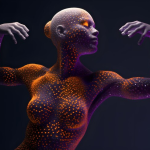Creating realistic skin and muscle deformation in 3D animation is a crucial aspect of bringing characters to life. Whether for films, video games, or virtual simulations, achieving believable and dynamic movements enhances the overall quality and immersion of the experience. This blog explores the essential techniques and considerations for achieving realistic skin and muscle deformation in 3D, highlighting the role of 3D animation services and incorporating collage animation as a creative technique.
Understanding Skin and Muscle Deformation
Before diving into techniques, it’s essential to understand why skin and muscle deformation are critical. When characters move, their skin and muscles shift and stretch in response to underlying bone and muscle movements. Accurate simulation of these deformations ensures that characters look natural and convincing, whether they’re performing a subtle facial expression or an intense action sequence.
Key Techniques for Realistic Deformation
-
Rigging and Skinning
Rigging is the process of creating a skeleton (rig) that controls a character’s movements. This rig is essential for animating the character, as it defines how different parts of the model will move. Skinning (or weight painting) involves attaching the character’s mesh to the rig so that the skin deforms correctly with the movement of the bones.
- Joint Placement: Place joints strategically to ensure they align with natural muscle groups. Incorrect joint placement can lead to unnatural deformations.
- Weight Painting: Adjust the weights to control how much influence each joint has over different parts of the mesh. Fine-tuning these weights is crucial for smooth and realistic deformations.
-
Muscle Simulation
Simulating muscle movement is a step beyond basic skinning. It involves creating a system that mimics the contraction and relaxation of muscles.
- Muscle Rigging: Create muscle rigs that interact with the character’s skin. These rigs simulate muscle movements and can be integrated with the skeleton.
- Muscle Dynamics: Use simulation tools to add dynamic effects to muscles. This includes creating bulging, stretching, and relaxing effects that respond to the character’s movements.
-
Blend Shapes (Morph Targets)
Blend shapes or morph targets are used to create facial expressions and other complex deformations. These are predefined shapes that blend with the base mesh to create various expressions or details.
- Creating Blend Shapes: Sculpt different facial expressions or muscle contractions as separate shapes. Blend these shapes with the base mesh to create dynamic and expressive animations.
- Animation Control: Use sliders or controls to adjust the influence of each blend shape, allowing for precise adjustments and smooth transitions.
-
Deformation Tools and Technologies
Advanced 3D animation software offers various tools to enhance deformation realism. Technologies such as subsurface scattering and dynamic skinning contribute to achieving lifelike results.
- Subsurface Scattering: This technique simulates how light penetrates and scatters within the skin, giving it a more realistic appearance.
- Dynamic Skinning: Advanced algorithms adjust the skin’s deformation in real-time based on muscle movements and external forces.
-
Simulation Techniques
Real-time and offline simulations can enhance the realism of skin and muscle deformations.
- Soft Body Dynamics: Simulate soft body dynamics for more complex interactions, such as skin sliding over muscles or fat.
- Physics-Based Simulation: Integrate physics-based simulations to handle interactions with other elements, such as clothing or environmental forces.
Incorporating Collage Animation
Collage animation is a technique where various elements, textures, and styles are combined to create a unique visual experience. While traditionally used in 2D animation, it can also be creatively applied in 3D animation to enhance realism and stylistic expression.
- Textural Collage: Combine different textures and materials to create unique skin and muscle appearances. This technique can add depth and detail to the character’s surface, enhancing realism.
- Visual Effects: Integrate collage animation techniques to simulate effects like scars, tattoos, or other surface details. This can make the character’s skin more dynamic and engaging.
Best Practices and Tips
-
Reference Real-Life Anatomy
Always use references from real-life anatomy when creating muscle deformations. Study how muscles and skin move and interact in different poses to ensure accuracy.
-
Regular Testing and Adjustment
Regularly test your deformations in various poses and animations. Adjust weights, muscle rigs, and blend shapes based on these tests to achieve the best results.
-
Use High-Quality Textures and Materials
High-quality textures and materials contribute significantly to realism. Use detailed and well-designed textures to enhance the appearance of skin and muscles.
-
Optimize Performance
While striving for realism, balance the complexity of your deformations with performance considerations. Optimize your models and animations to ensure they run smoothly in real-time applications.
The Role of 3D Animation Services
3D animation services play a crucial role in achieving realistic skin and muscle deformation. Professional services provide expertise in rigging, skinning, muscle simulation, and advanced deformation techniques. They offer:
- Expertise and Experience: Skilled animators and technical artists bring years of experience to ensure high-quality results.
- Advanced Tools and Technologies: Access to cutting-edge software and tools that facilitate realistic deformations and simulations.
- Customization and Precision: Tailored solutions that meet specific project requirements, ensuring that animations are both realistic and visually appealing.
Conclusion
Creating realistic skin and muscle deformation in 3D is a complex but rewarding process that significantly enhances the quality of animations. By employing advanced techniques in rigging, skinning, muscle simulation, and utilizing tools such as blend shapes and physics-based simulations, animators can achieve lifelike results. Integrating creative techniques like collage animation can further enrich the visual appeal and uniqueness of 3D characters. Collaborating with professional 3D animation services ensures that these techniques are implemented effectively, leading to animations that are both dynamic and convincing. Whether for film, games, or other digital media, mastering these techniques is key to delivering high-quality, realistic animations that captivate and engage audiences.












